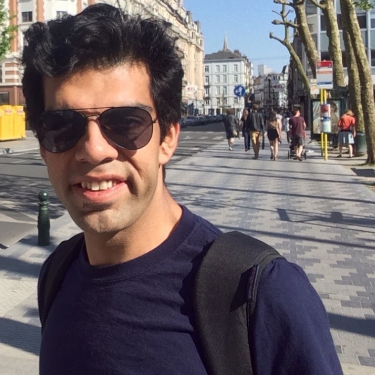
-- In "The Great Gatsby" by F. Scott Fitzgerald
This page contains information on some fun and interesting projects. I have made sure theres atleast a project report for each. Additionally, some have a short PPT for a quick overview. Over the next few weeks, I will try my best to dig up the code and make that available.
Studying Immersion in VR
Aurally Guided Navigation in VR
CryptoShooter
Physically Based Modeling
I recently took a course on "Physically Based Modeling and Simulation" at UNC. Aside from studying numerical techniques, I also got the chance to explore the Unity 4 game engine. Here are some really cool physically based toys to analyze/play with:
Projectile Simulation
Here's a 3D artillery simulator built in Unity. The user can change the mass of the projectile, amount of powder, the azimuth and elevation of the gun barrel. The user can also select one of two numerical integration methods: Eular or 4th order Runge-Kutta. Note: Due to an issue with unity, the web player version doesnt accept multiple inputs requiring the user to refresh the page for each file. Try one of the executables instead.
Spring Simulation
The following application simulates a vertical spring with a user defined mass and spring constant, not stretched at first, under the effect of spring and gravitational forces. As before, the user can select one of methods: Eular or 4th order Runge-Kutta.
Bead on a circle
The following application simulates the motion of a particle constrained by a unit circle. It accounts for the gravitational force, dampening and a optional user applied force. All parameters can be changed during runtime. Note: The web player doesn't visualize the circle, try one of the executables instead.
Learning Latent Factor Models of Human Travel
A 'good' travel model could yield new scientific insights into human behavior, aside for being useful in numerous applications. For example, travel models can help in predicting the spread of disease; surveying tourism, traffic, and special events mobility for urban planning; geolocating with computer vision; interpreting activity from movements; and recommending travel. The objective of our project was to implement a basic latent travel model. Essentially, we model travel probabilities as functions of spatially-varying latent properties of locations and travel distance. The latent factors represent interpretable properties: travel distance cost and desirability of locations. These latent factors are combined in a multiplicative model which easily lends itself to incorporating additional latent factors and sources of information.
Food Detection in Images
Graph based Image Segmentation
The goal of this project was to implement and thorougly analyze the image segmentation algorithm proposed by Felzenszwalkb et. al. (2004). The proposed method defines a metric for measuring the evidence of a boundary between two regions using a graph-based representation of the image. Based on the proposed metric, an efficient image segmentation algorithm is developed. Although this algorithm is a greedy algorithm, it respects some global properties of the image. Some important features of the proposed algorithm are that it runs in linear time and that it has the capability to adapt its behavior differently between regions of high-variability and low-variability. In particular, we demonstrate that it ignores details in high-variability regions.
Real Time Object Recognition
In 2012, I spent a wonderful summer interning at the Technischen Universität Berlin, with the Neural Information Processing Group under the guidance of Dr. Johannes Mohr and Prof. Klaus Obermayer. I worked on developing a recognition system that is largely scale-, illumination-, orientation-invariant and can be used on any object regardless of its shape or size. The recognition system is also capable of recognizing objects in a cluttered scene in almost real time.
Content based Image Retrieval & Browsing
In 2011, I interned at the Defence Research & Development Organization, India with the Defence Terrain Research Lab. During my time there I developed CTD, a unique feature descriptor,for color image retrievel and browsing. A key goal of the project was to allow satellite image browsing which can be used to detect military installations.
Global & Local Latency Analysis
Our goal was to study and analyze the patterns observed during IP packet transfers through various locations around the world. Packets take different routes to reach a specific destination and our goal was to observe the variation in their latencies and check if there is any behavioral pattern for traces on weekdays and weekends. Also we studied the dependence of latency with respect to distance of the destination from source and for different countries. Additionally, we observed that there are at times transatlantic hops in some ‘local’ pings and we reported the observation and its impact it has over the network.
Hand Gesture Recognition
During my final year of undergraduate studies, I worked on American Sign Language recognition using the Microsoft Kinect camera. I also designed and implemented specific GUI applications, such as paint, using hand gestures as input.
The following application can be used to generate a random roadmap for a given scene. Notes on installation/compilation instructions for win 32 and further details on usage can be found in the Readme.